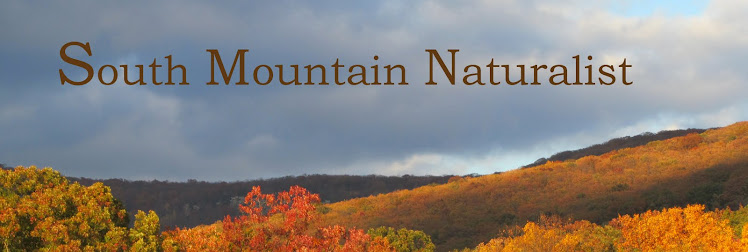On December 31, 2010, not far from the entrance to Greenbrier State Park, I spied a small flock of wild turkeys wandering through the woods. Meleagris gallopavo is not the prettiest of North America's native birds.
 |
| Mounted bird at Smithsonian Naturalist Center |
Both males and females have featherless heads. Adult males develop a fleshy appendage beneath the jaw called a wattle, and growths on their necks called caruncles. They also sport a triangular protrusion from the top of their head called a snood. When a male turkey is distressed or in breeding mode, the wattle, caruncles, and snood become engorged with blood, turn red and enlarge. The snood may extend until it resembles a long fat juicy worm draped over the male's beak.
This feature may detract from his appearance to humans, but likely makes him irresistible to female turkeys.
Even to humans, however, wild turkey plumage can be quite beautiful. A male's feathers are glossy, glittering in shades of bronze, green, gold, red and purple. Females have more muted plumage in browns and greys. Males are frequently depicted in the iconic "display" posture, body feathers ruffled and puffed, barred wings outstretched and trailing seductively, with tail erect and fanned like a peacock. Termed gobblers or toms, males have a diverse repertoire beyond the eponymous gobble, including grunts, purrs, whines, cackles, yelps, and a rapid drumming. In breeding season, like many birds, they use both display and vocalizing to lure females and establish territory.
For habitat, wild turkeys like open woodland and grassland where they can fly close to the ground, and easily find perches. Turkeys prefer to eat hard mast (seeds of forest trees such as acorns and nuts). They also forage other types of seeds, berries, roots and grasses, and may devour insects, small amphibians or reptiles. South Mountain's oak trees produced an unusual bounty of acorns this year. Not surprisingly, these turkeys looked well-fed even in the midst of winter.
Midsummer in 2010, I had an even closer encounter. It was a warm afternoon and I was absent-mindedly picking and eating wine berries growing along the trail. I threaded my way deeper and deeper into the bramles, tempted by the sight of more ripe berries. Suddenly there was an explosive sound at my feet, and a huge whirring shape shot high into the air. Just as suddenly, the turkey (for what else could it be?) dropped and disappeared into the brush beyond. Heart thumping, I glanced down and saw about a dozen gleaming eggs directly in front of me. It was like finding a treasure.
I took just a moment to admire the perfect ovoids. Each one seemed about twice the size of a grocer's extra- large. Cinnamon-brown dusted the smooth creamy shells.. The clutch rested directly on layers of last autumn's leaves, which were matted into a shallow depression the shape of the hen's body. Some scattered twigs were the only other components of the nest. Berry canes arched overhead to form a protective bower. The hen had chosen her setting place well--she need only extend her neck to nibble wine berries. Feeling like an intruder, which I certainly was, I quietly retreated.
Wild turkey hens usually lay 10 to 12 eggs over a two week period. They carefully tend and turn the eggs during incubation. In about 28 days the poults (chicks) hatch and must leave the nest within 24 hours to feed. At first the poults are unable to fly and very vulnerable. The hen and her brood must roost at night on the ground. A hungry raccoon, skunk, opossum or snake would love to find a cache of turkey eggs or newly- hatched poults!
 |
In my research, I learned that there are five subspecies of Meleagris gallopavo native to North America. The turkeys inhabiting South Mountain are M. gallopavo silvestris, also referred to as the Eastern Wild Turkey. It is the most common of all the subspecies, ranging over the entire eastern half of the U.S. Our largest game bird, it can grow up to four feet tall and weigh some thirty pounds.
Coyotes, great horned owls, and foxes prey on adult wild turkeys, but for centuries the species' most voracious predator has been Homo sapiens. By the 1940s, the once plentiful bird was almost extinct in the U.S. and Canada. Since then, conservation efforts have succeeded in restoring respectable numbers of M. gallopavo. Let's give thanks that the Wild Turkey Federation estimates the current population at 7 million!



No comments:
Post a Comment